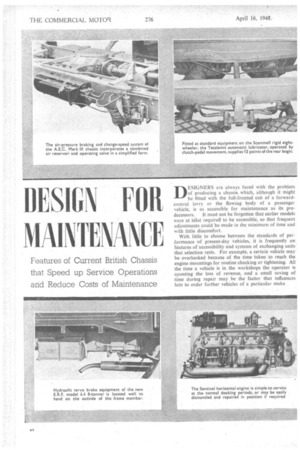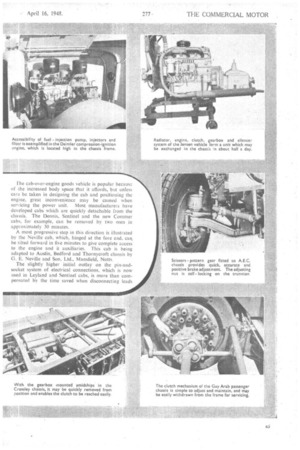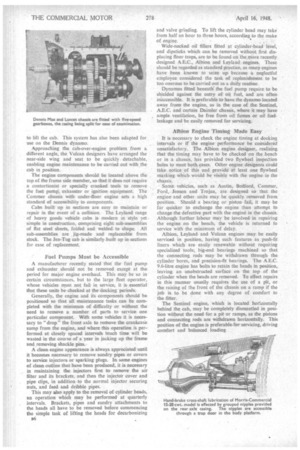DESIGN FOR MAR TRANCE
Page 38

Page 39

Page 40

Page 43

If you've noticed an error in this article please click here to report it so we can fix it.
DESIGNERS are always faced with the problem of producing a chassis which, although it might be fitted with the full-fronted cab of a forwardcontrol lorry or the flowing body of a passenger vehicle, is as accessible for maintenance as its predecessors., It must not be forgotten that earlier models were at least required to be accessible, so that frequent adjustments could be made in the minimum of time and with little discomfort.
With little to choose between the standards of performance of present-day vehicles, it is frequently on features of accessibility and systems of exchanging units that selection rests. For example, a certain vehicle may be overlooked because of the time taken to reach the engine mountings for routine checking or tightening. All the time a vehicle is in the workshops the operator is counting the loss of revenue, and a small saving of time during repair may be the factor that influences him to order further vehicles of a particular make rhe cab-over-engine goods vehicle is popular because of the increased body space that it affords, but unless care be taken in designing the cab and positioning the engine, great inconvenience may be caused when servicing the power unit. Most manufacturers have developed cabs whiCh are quickly detachable from the chassis. The Dennis, Sentinel and the new Commer cabs, for example, can be removed by two men in approximately 30 minutes.
A most progressive step in this direction is illustrated by the Neville cab, which, hinged at the fore end, can, be tilted forward in five minutes to give complete access to the engine and it auxiliaries. This cab is being adapted to Austin, Bedford and Thornycroft chassis by G. E. Neville and Son, Ltd., Mansfield, Notts.
The slightly higher initial, outlay on the pin-andsocket system of electrical connections, which is now used in Leyland and Sentinel cabs, is more than compensated by the time saved when disconnectimr, leads
to lift the cab. This system has also been adapted for use on the Dennis dynamo.
Approaching the, cab-over-engine problem from a different angle, the Vulcan designers have arranged the near-side wing and seat to be quickly detachable, enabling engine maintenance to be carried out with the cab in position.
The engine components should be located above the top of the frame side member, so that it does not require a contortionist or specially cranked tools to remove the fuel pump; exhauster or ignition equipment The Commer chassis with under-floor engine sets a high standard of accessibility. to components.
Cabs built up in sections are easy to maintain or repair in the. event of a collision. The Leyland range of heavy goods vehicle cabs. is modern in style yet simple in construction, comprising eight sub-assemblies of flat steel sheets, folded and welded to shape. All sub-assemblies are jig-made and replaceable from. stock. The Jen-Tug cab is similarly ,built up in sections for ease of replacement.
Fuel Pumps Must be Accessible
A manufacturer recently stated that the fuel pump and exhauster should not be removed except at the period for major engine overhaul. This may be so in certain circumstances, but to the large fleet operator, whose vehicles must not fail in service, it is essential that these units be checked at the docking periods.
Generally, the engine and its components should be positioned so that all maintenance tasks can be completed with the minimum of difficulty or without the need to remove a number of parts to service one particular component. With some vehicles it is necessary to "drop" the front axle to remove the crankcase sump from the engine, and where, this operation is performed at closely spaced intervals 1nuch time will be wasted in the course of a. year in jacking up the frame and removing shackle pins..
A clean engine appearance is always appreciated until it becomes necessary to remove sundry pipes or covers to service. injectors or sparking plugs. In some engines of clean outline that have been produced, it is necessary in maintaining the injectors first to remove the air filter and its brackets, and then the inject& cover and pipe clips, in addition to the normal injector securing nuts, and feed and dribble pipes.
This may also apply to the removal of cylinder heads, an operation which may be performed at quarterly intervals. Brackets, pipes and sundry attachments to the heads all have to be removed before commencing the simple task of lifting the heads for decarbonizing
B6 and valve grinding. To lift the cylinder head may take from half an hour to,three hours, according to the make of engine.
Wide-necked. oil fillers fitted at cylinder-head level, and dipsticks which can be removed without first displacing floor traps, are to be found.on themore recently designed A.E.C., Albion and Leyland .engines. These should be regarded as standard practice, as many engines have been known to seize up because a neglectful employee considered the task of replenishment to be too onerous to be carried out as a daily routine.
Dynamos fitted beneath the fuel pump require to be shielded against the entry of oil fuel, and are often inaccessible. It is preferable to have the dynamo located away from the engine, as in the case of the Sentinel, A.E.C. and certain Daimler chassis, where it may have ample ventilation, be free from oil fumes or oil fuelleakage and be easily removed for servicing.
AlbionEngine Timing Made Easy It is necessary to check the engine timing at docking intervals or if the engine performance be considered unsatisfactory. The Albion engine designer, realizing that the timing may have to be checked on .the .bench or in a chassis, has provided two flywheel inspection holes to meet both, cases. Other engine designers could take notice of this and provide at least one flywheel marking which would he visible with the engine in the chassis.
Some vehicles, such as Austin, Bedford, Commer, Ford, Jensen and Trojan, are designed so that the engine and other units may, be quickly removed from position. Should a bearing or piston • fail, it may be far quicker to exchange the engine than attempt to change the defective part with the•engine in the chassis. Although further labour may be involved in repairing the engine on the bench, the vehicle is returned to service with the minimum of delay.
Albion, Leyland and Vulcan engines may be easily serviced in position, having such features as push-fit liners which are easily renewable withont requiring specialized tools; big-end bearings machined so that the connecting rods may be withdrawn through the cylinder bores, and precision-fit bearings, The A.E.C. 9.6-litre engine has bolts to retain the heads in position, leaving, an unobstructed surface on the top of the cylinder when the heads are removed. To effect repairs in this manner usually requires the use of a pit, or the raising of the front of the chassis on a ramp if the job is to be done with any degree of comfort to the fitter.
The Sentinel engine, which is located horizontally behind the cab, may be completely dismantled in position without the need for a pit or ramps, as the pistons and connecting rods are withdrawn horizontally. This position of the engine is preferable.for servicing, driving comfort and balanced loading
Where the distributor-unit exchange system is applicable, or where. the operator holds a float of units, it is essential that the design should be adapted to facilitate quick. changing of units. Radiators,' 'crossmembers and engine cowlings that are easily removable assist in speeding up the operation, and lifting eyes permanently attached to the cylinder 'heads ensure that no damage is caused when slinging the engine. These are features of AlbiOn and Crossley engines. It is claimed thatthe .Derinis engine can be withdrawn, from position by two men in less than an hour, and the task of exchanging the engine, testing the vehicle and making final adjustments 'can be fulfilled in less than a day. Provided that the component parts have not to be "changed, "almost .every make of engine can be exchanged by competent labour within the working day. By. mounting the gear selector lever 'and pedal brackets on the frame, side member, and in such a manner that they do. not overhang to impede a straight withdrawal of the engine; work is greatly facilitated.
Should an engine, like the A.E.C., be secured at three points, there are few bolts to be removed and replacement of the power unit is simplified. Jensen Motors, Ltd., has gone a step farther with the replacement system by standardizing a unit composed of the radiator, engine, clutch, gearbox and silencer system, which may be exchanged and the vehicle made ready for service within half a day The Jen-Tug power unit is built up on a sub-frame'to include the transmission and rear axle, and may be removed by one man in less than 20 minutes. It is not necessary to drain off oil or water, or. remove the exhaust system for this operation. Engine replacement in Crossley,. Dennis, Guy and Tilling-Stevens chassis is simplified by fitting the gearbox as a separate unit. This expedites inspection or changing the clutch plates, as it is necessary to disconnect only the driving coupling before unbolting the clutch back plate. . .
A gearbox located amidships in the chassis may be speedily removed for inspection or repair. Large inspection covers or split gearbox casings of the Dennis, Guy and Tilling-Stevens gearboxes enable quick examinations to be made, and parts to be exchanged in the minimum of time. Selector mechanism bolted to the main gearbox casing is More easily m' aintained than an integral unit. .
Modern vehicles have rear. axles constructed with high-grade materials and are Of generous proportions which provide a large factor Or safety it is necessary to remove the. final-drive ,unit-lor.:oecasional inspection or repair; an' operation .whichis most easily performed when the axle is of th&fullyiloating,pattern With a semi floating axle the time factor of jacking tip the axle, removing the wheels and WithdraWing the hubs and races. is ‘considerably greater. than that Of a fully floating unit, where the driving shafts may be with' drawn without removing the wheels: In the multiiwheeled range, the Dennis -Jubilant bogie is designed to be withdrawn from position with little effOrt.
Brake servo systems and methods of adjustments are varied, but for ease' Of 'maintenance the Albion servo system, which dispenses with the usual piimp Or Motor, is outstanding.. With no rotating Paris; this system requires little or no attention-after initial adjustment
For passenger service, where perhaps eight or more stops are made to every mile, daily adjustments for facing wear are often needed. A.E.C. vehicles fitted with high-lift cams and scissor-pattern adjusters provide long periods of life before it is necessary to fit a packing piece which enables full advantages to be taken
of the thick facings.
Automatic brake adjusters find favour with many passenger-vehicle operators, especially where the vehicles are operating in congested areas with frequent use of the brakes. It has been known for buses equipped with automatic brake adjusters to run the full docking period without manual adjustment or a decline of efficiency
• Safeguard in Foden Brake Adjusters Automatic adjusters fitted to Foden vehicles incorporate a backwind device which enables the shoes to be slackened off if over-adjustment has taken place. and a wear stop which permits the facings to wear down to a predetermined thickness before the automatic action ceases. This prevents the brake shoes from coming into contact with the drum after the facing has been worn away.
The grouped-nipple lubrication system is an advance on previous greasing methods, particularly where the nipples are assembled in a position easily reached by a lubrication .gun. This system is becoming increasingly popular and is exemplified on the Morris-Commercial arid new E.R.F. goods chassis. The automatic lubrication equipment which forms a standard fitment to the Scam-pelt rigid eight-wheeler is frequently offered by other vehicle manufacturers as an optional item, and provided that the container is kept supplied with lubricant will save many man-hours during the course of a year Experience shows that the continuous supply of lubricant maintains a film of oil over the essential parts, which greatly reduces the rate of wear. This is found more than to justify the initial outlay, and the demand for automatic lubrication is keen among overseas operators. Oil-less bushes fitted to the MorrisCommercial 5-ton model reduce the number of points requiring lubrication. Leyland bus chassis are now being fitted with Metalastik rubber-bonded shackle pins, thus eliminating 12 lubrication points.
The position of the battery is important, because if it be inaccessible the battery may be overlooked during normal maintenance. Crossley battery crates, which are mounted outside the frame side member; have extension pieces attached to their front ends, which enable the battery to be drawn clear of the body.












































































